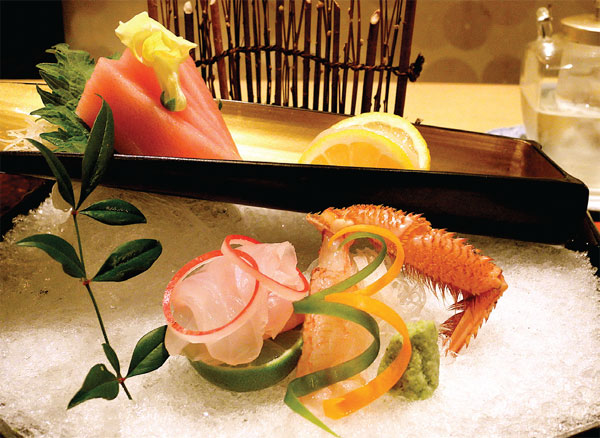Cherry blossom cuisine
Updated: 2015-04-03 07:45
By Maggie Beale(HK Edition)
|
|||||||||
Relaxing and unpretentious, the contemporary setting is muted with soft carpeting and rich wooden ceiling beams, a comfortable setting that provides a positive platform for the Kansairori or Kansai regional cuisine specialities of this Nadaman restaurant. Kaiseki style is an art form of the multi-course Japanese dinner that values the look of each dish, the presentation and its setting just as much as the taste and texture of the food.
Well-versed in the centuries-old culinary arts of Japan, chef Takao Kojima oversees a skilled team of sushi and teppenyaki chefs.
To whet the appetite; a dainty glass of boiled spring broccoli florets in a sesame seed and dashi jelly, the flavour was high and the texture appropriate. Dashi is the quintessential umami-rich stock made with bonita flakes used throughout Japanese cooking.
Then a homemade silky-smooth 'sakura' (cherry-blossom) sesame tofu topped with sea urchin arrived. The foie gras of the sea, sea urchin is a particular favourite of mine, and this was briny, sweet and tasty. It was lightly flamed at the table as part of the Kasekai experience.
Next a dish of tiny new potatoes simmered in shuto cream sauce were a bit of a letdown in taste but soon forgotten with the arrival of fresh sashimi; luscious Toro tuna, Japanese hairy crab and scallops. Succulent and sumptuously fresh with aromas of the sea it was, without a doubt, the best Toro Tuna we've ever come across.
From this juncture onwards, an Aramasa sake was served throughout the rest of the dinner. This sake served cold was deemed to be ideal for both the seafood and the meat dishes that were to come. Recommended by multi-lingual (a boon for foreign visitors) manager Andy Ho, this sake was produced in northern Japan in the Akita Prefecture, the rice used was harvested in 2013 and 40 percent polished to give a sake that is soft and smooth on the palate yet with flavours akin to a light sherry or rice wine that has a good medium finish.

Next, a steamed tilefish was served with an essence of Nameko mushroom sauce. It was served in prettily painted, glazed pottery-ware bowls. This was followed by Tempura dishes of deep-fried firefly squid and spring vegetables. Fly-off-the-tongue crispy the squid was memorably crunchy and the veggies a fitting accompaniment.
To cleanse the palate before the meat course, a bowl of steamed egg custard with Japanese Asari clam was served next. I'm not a big clam fan - but I did like this mainly because of its delicacy.
With the more delicate dishes properly appreciated and savoured it was now time for the "main" course; plump, succulent slices of char-grilled Miyazaki beef sirloin steak. Juicy, melt-in-the-mouth and umami-rich the meat was served on a bed of mashed potatoes. The dish was also accompanied by grilled root vegetables along with wasabi soy sauce and a plum mustard sauce.
Last, but certainly not least, the Sushi Chef Furuyama presented an assortment of sushi ranging from abalone, toro tuna, yellowtail and salmon. A fitting conclusion to a meal of Japanese cuisines that have wowed diners for several centuries.
To finish this Omakase Kaiseki feast, a platter of seasonal Japanese fruits with white strawberries and honey melon was served with a welcoming cup of hot Japanese green tea.
With seating for 138 people, there's a main dining area, a 12-seat sushi bar, private Teppanyaki room with a long T-shaped table and Teppanyaki grill that seats up to 16 people, a divisible deluxe private dining room and tatami room.
Typical prices include: Teppanyaki Tsuzumi at HK$1,050 for goose liver, scallops, assorted vegetables, Australian Wagyu sirloin, fried rice, pickles, soybean soup and dessert. Or there's a Tasting Set with Otoro tuna, uni, shrimp, and egg for HK$260. A California Hand roll at HK$75, or Maguro temaki red tuna at HK$100.
Family gatherings and groups of friends were in evidence each time I've been there.

(HK Edition 04/03/2015 page8)